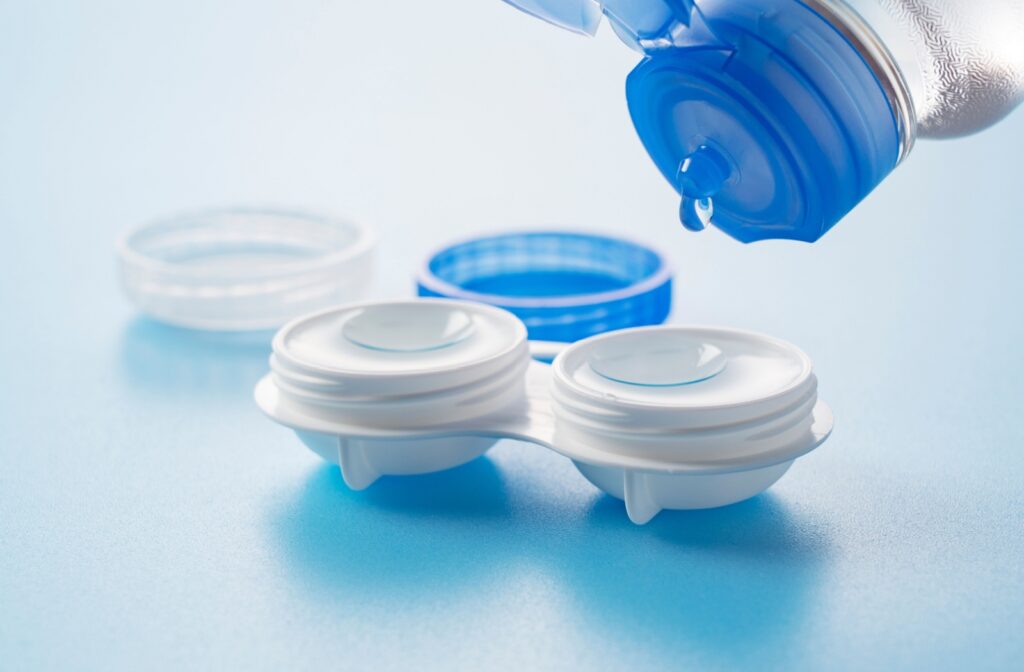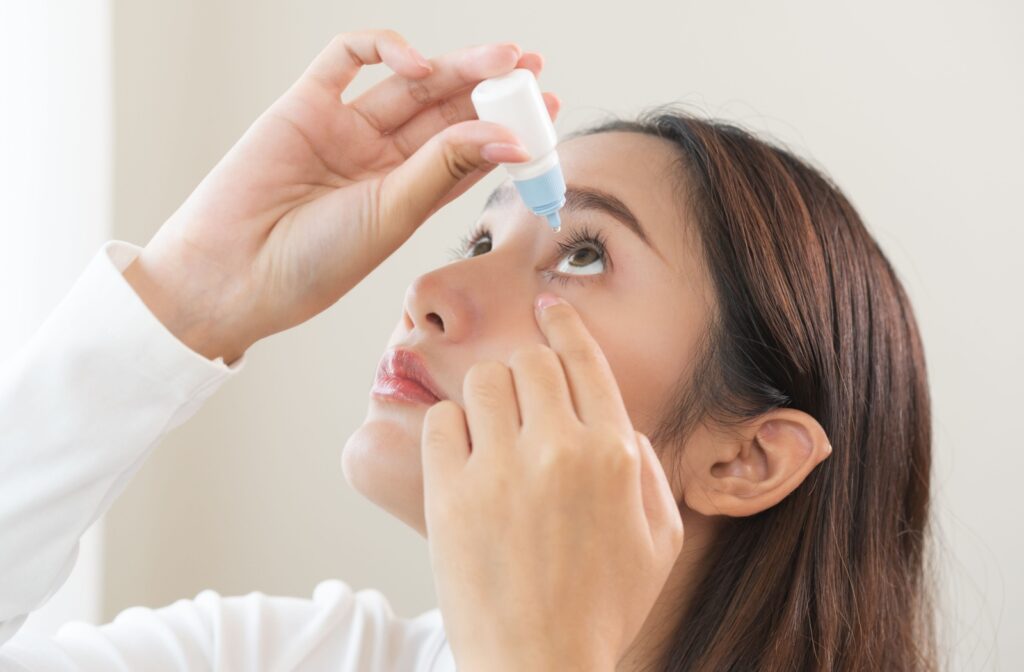If your eyes are feeling dry or irritated and you’re out of eye drops, you might be tempted to reach for your contact lens solution as a quick fix. But can you put contact solution directly in your eye? The short answer is: No, you shouldn’t.
While contact solution might seem harmless (after all, it’s used with lenses that go in your eyes) it’s not designed to be applied directly to your eyes like eye drops.
This is a common question among contact lens wearers, especially those using multi-purpose solutions that clean, rinse, and store lenses. But it’s important to understand the difference between contact solution and eye drops, and how to use each one correctly.
Eye Drops vs. Contact Lens Solution: What’s the Difference?
Even though both eye drops and contact solutions may look similar, their purposes and ingredients are quite different.
Eye drops are specifically formulated to treat the eyes. Depending on the type, they might be used to:
- Relieve dryness or irritation
- Treat allergies
- Reduce inflammation
- Fight infection
Some are made with preservatives, while others are preservative-free to avoid irritating sensitive eyes.
Contact lens solutions, on the other hand, are designed to clean, disinfect, and store contact lenses. These solutions may contain chemicals like hydrogen peroxide or borate compounds, agents that are too harsh for direct use in your eyes. While multi-purpose solutions do allow for rinsing lenses before insertion, they’re not meant to function like lubricating drops or provide relief for dry eye.
Why You Shouldn’t Use Contact Solution as Eye Drops
The base of many contact solutions is saline, which is safe for the eyes. But saline is just one component. The other ingredients used to clean and disinfect lenses are not typically safe for direct application to the eye’s surface. If contact solution is used as a substitute for eye drops, it could result in:
- Stinging or burning sensations
- Dryness and irritation
- Disruption of the tear film
- Possible damage to the corneal surface
Even if it seems fine the first time, regular use can lead to complications and discomfort.
What Happens If You Accidentally Put Contact Solution in Your Eye?
Accidentally using contact solution in your eye once, especially a multi-purpose solution, usually won’t cause lasting harm, though you might experience some temporary discomfort. If the solution contains hydrogen peroxide (like in a cleaning system that requires a neutralizing step), you may feel significant burning or irritation. In such cases:
- Remove the contact lens if it’s in place
- Rinse your eye with sterile saline or clean water
- Contact your optometrist if symptoms persist
Can You Use Eye Drops as a Substitute for Contact Solution?
The reverse situation also raises questions, can you store your contacts in eye drops if you run out of solution? Again, the answer is no.
Eye drops:
- Are not sterile enough for lens storage
- Don’t disinfect or remove protein build-up
- Can damage your contacts or introduce bacteria
Storing lenses in eye drops can put you at risk of eye infections or discomfort when you reinsert the lenses.
Which Eye Drops Are Safe to Use with Contacts?
There are specific types of eye drops that are labelled “safe for use with contact lenses.” If you’re dealing with dryness or irritation while wearing lenses, these are the drops you should look for.
Here are some types of drops you might encounter:
Lubricating Eye Drops (Artificial Tears)
- Help relieve dryness, especially in air-conditioned environments or after screen time
- Some are safe to use with contacts, but look for labels that specify this
- Preservative-free options are ideal for sensitive eyes or frequent use
Antihistamine Eye Drops
- Designed to reduce itching, redness, and swelling due to allergies
- Some are safe to use with lenses, while others should only be used without them—check the label or ask your eye doctor
Antibiotic Eye Drops
- Prescribed to treat bacterial eye infections like conjunctivitis (pink eye)
- Not to be used with contacts; you should typically stop wearing lenses during treatment
Steroid Eye Drops
- Used for post-surgical care or to manage serious inflammation
- Must only be used under the supervision of your optometrist or ophthalmologist
How to Use Contact Solution Properly
Contact solution plays a critical role in keeping your lenses safe and comfortable. Here’s how to use it the right way:
- Always clean lenses after removal by rubbing them gently with solution and rinsing before storing
- Never reuse old solution in your lens case
- Do not mix brands unless your eye doctor says it’s okay
- Replace your case every 1–3 months to prevent bacterial buildup
- Store contacts only in contact lens solution, not water, saline, or eye drops

When to See Your Eye Doctor
If you find yourself frequently reaching for any kind of drop (lubricating, allergy-relief, or otherwise) it’s worth speaking to your eye doctor. Chronic dryness, irritation, or discomfort while wearing contact lenses may be a sign of:
- Poor lens fit
- Incompatible lens material
- Dry eye syndrome
- Allergies
- Improper lens care
Your optometrist can help determine the right solution, whether that means switching lens brands, adjusting your care routine, or recommending medical treatment.
Need Help Choosing the Right Drops or Lens Solution?
Understanding the difference between eye drops and contact solution is essential for protecting your eye health and promoting comfortable lens wear. Contact solution should never be used directly in your eye and eye drops should never be used to clean or store your contacts.
If you’re unsure which products are right for you or are dealing with ongoing discomfort, the team at Santa Cruz Optometric Center is here to help. Schedule an appointment today to get personalized guidance and keep your eyes happy and healthy.



